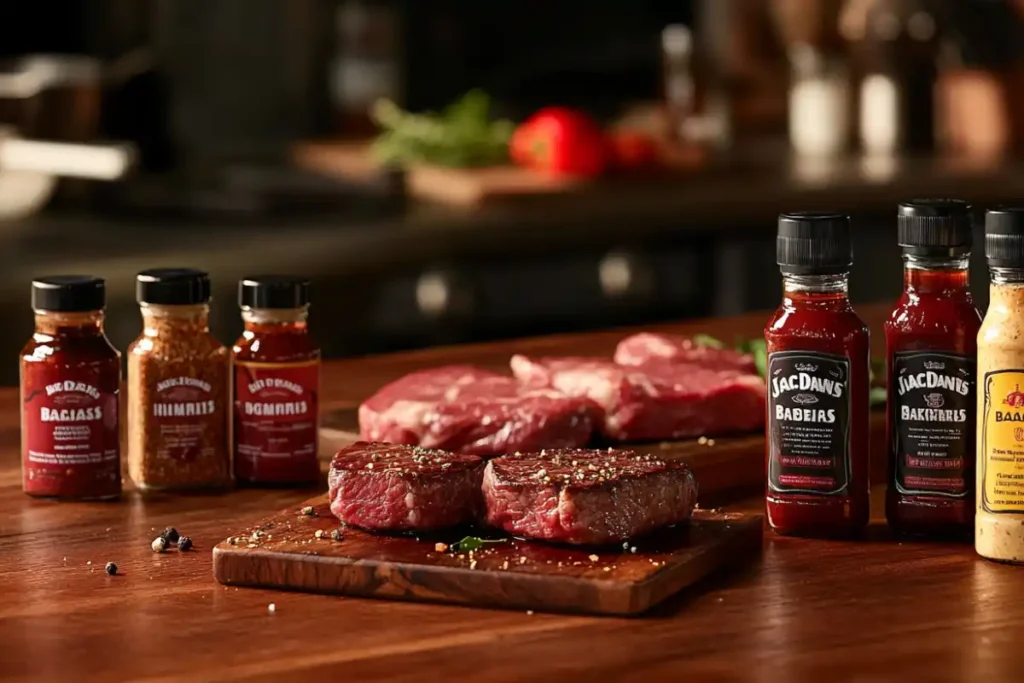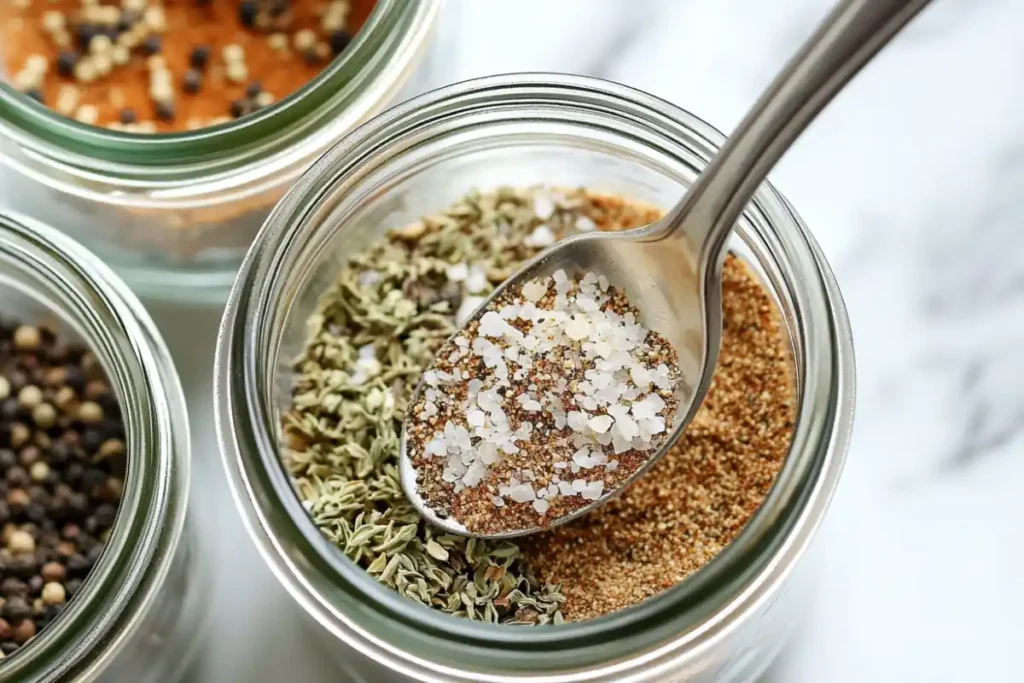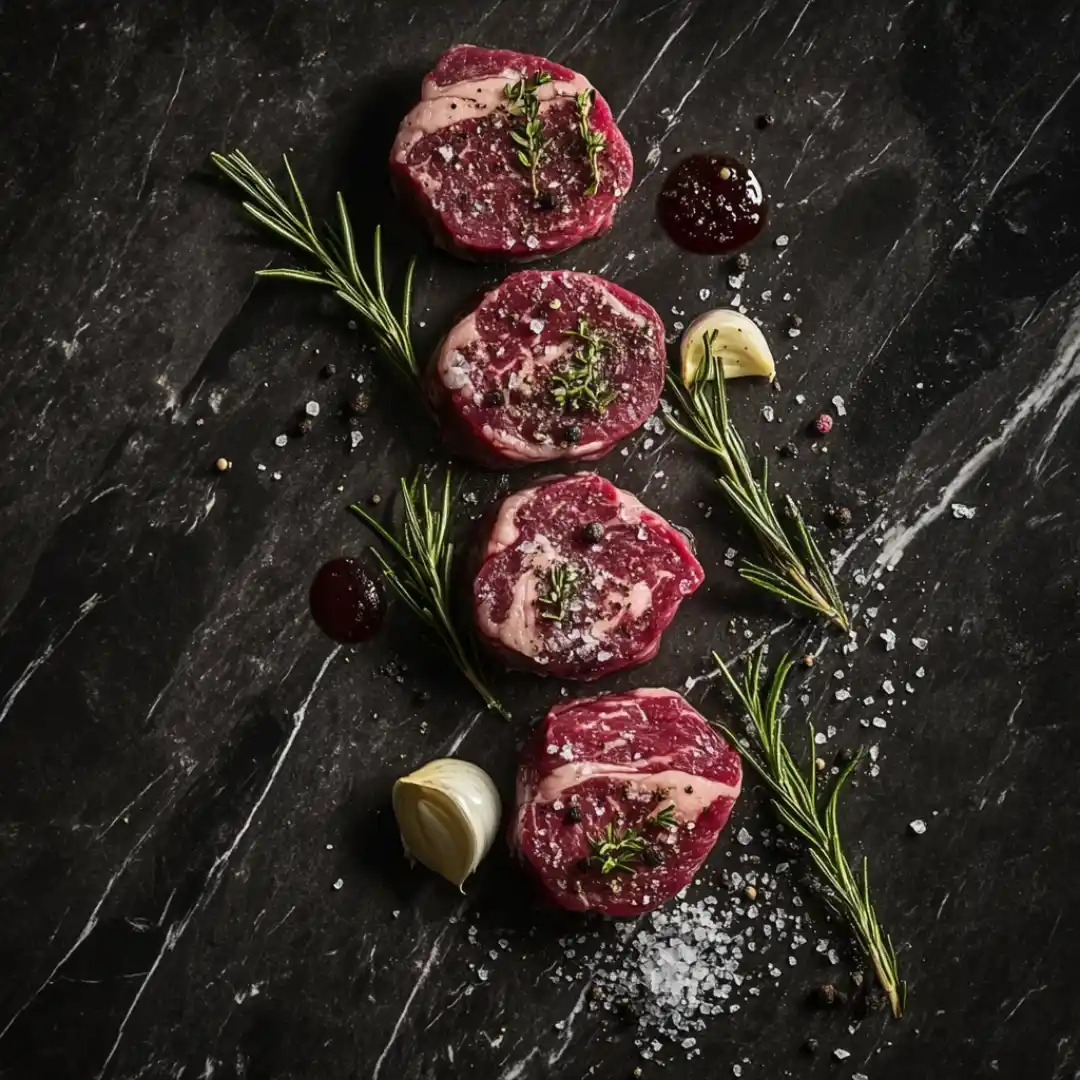There’s just something magical about biting into a perfectly seasoned steak, right? That crispy, flavor packed crust, the juicy center, it’s a carnivore’s dream. But here’s the secret: even the most tender cut of beef can fall flat without the right steak seasoning. Whether you’re grilling in the backyard or pan searing in your kitchen, choosing the right blend can make or break your steak game.
In this guide, we’ll walk you through everything you need to know about steak seasoning, from top store bought blends and DIY recipes to how to use them based on your steak cut and cooking method. You’ll even learn how to dodge common seasoning mistakes and get pro tips to elevate your next cookout.
What Is Steak Seasoning and Why It Matters
Understanding Steak Seasoning: More Than Just Salt and Pepper
Most folks think a shake of salt and a pinch of pepper are enough for steak. And while those basics are important, they’re only the beginning. Steak seasoning is a bold blend of spices, herbs, and sometimes even aromatics that enhance the natural flavor of beef. Think of it like this, your seasoning is the soundtrack to your steak. It sets the tone, adds depth, and makes the whole experience unforgettable.
Common ingredients include black pepper, garlic powder, smoked paprika, and onion powder, but many blends go way beyond that. Some throw in caraway seeds for a punch of earthiness, while others lean into buttery or smoky notes that mimic steakhouse flavor. These combinations don’t just sit on the surface, they interact with the meat’s juices during cooking, creating that iconic crust and flavor burst with every bite.
The Role of Seasoning in Enhancing Meat Flavor
Now, let’s be real, steak on its own already tastes pretty darn good. But when you season it right? Oh, baby. The right steak seasoning can draw out those savory, umami rich flavors and add just the right contrast to the fat and char. It’s all about balance. Too bland, and your steak falls flat. Too salty, and you overpower the meat.
This is where flavor boosters like smoked salt, cracked peppercorns, and herbs like thyme or rosemary come into play. They don’t cover the taste, they amplify it. Plus, a well crafted seasoning helps build that crave worthy crust during searing or grilling.
So whether you’re using a dry rub for steak, a steakhouse style mix, or whipping up your own spice blend, don’t underestimate the power of seasoning. It’s the not so secret weapon in every steak lover’s toolkit.
The Best Steak Seasonings You Can Buy Today
Top Rated Store Bought Steak Seasonings in 2025

Let’s face it, sometimes we don’t have time to whip up our own blend. That’s when store bought steak seasonings come to the rescue. Luckily, 2025 has blessed us with some real flavor heroes. Among the best, Kinder’s The Steak Blend stands tall. This smoky, slightly sweet rub is a go to for those who want to mimic that steakhouse flavor without firing up the grill.
Another top contender? Jack Daniel’s Steak Seasoning. Packed with black pepper and bold garlic, it gives off those rugged saloon vibes while delivering a punch of flavor that’s perfect for ribeye or sirloin.
And don’t overlook Badia’s Canadian Blend. With hints of caraway and coarse sea salt, this one’s all about bold, earthy undertones. Sure, it might not be everyone’s jam, but if you’re after complex, layered flavor, this is your guy.
Looking for something buttery and smooth? Kinder’s Buttery Steakhouse Rub smells like movie popcorn and works great on veggies and chicken, even if it’s not the MVP for steak.
Tasting Notes: From Jack Daniel’s to Montreal Steak Seasoning
Each seasoning has its own flavor fingerprint. Montreal Steak Seasoning, for instance, is a classic. You’ll get that peppery kick with a touch of paprika and garlic, ideal for grilling.
Weber’s Chicago Steak Seasoning brings more heat, with a bolder chili pepper base, while McCormick’s Spicy Montreal caters to spice lovers who like a slow burn with every bite.
What makes these great? They deliver bursting flavor, crust friendly textures, and all around beef enhancing power. Whether you’re pan-searing or grilling outdoors, there’s a store bought option that fits your cooking style and taste buds.
And hey, if you’re still wondering how these compare to other blends or want to know what makes a seasoning mix special, check out this detailed guide on seasoning mixes for extra insight.
Key Ingredients in the Best Steak Seasoning Blends
Essential Spices: Salt, Pepper, Garlic, and More
Every great steak seasoning starts with a solid base, salt and black pepper. Salt enhances the natural juices in the meat, while pepper adds that spicy, warming kick that balances out the fat. But that’s just the beginning.
You’ll often find garlic powder and onion powder in top blends. Why? Because they bring that rich, savory punch without overpowering the meat’s flavor. They’re also excellent at sticking to the surface and building a flavorful crust.
Other usual suspects? Smoked paprika adds color and a touch of sweetness, while crushed red pepper flakes offer heat. Some mixes even feature brown sugar to balance spiciness with a hint of sweet.
Flavor Boosters: Paprika, Caraway, and Umami Elements
Want to take your seasoning from good to gourmet? Look for umami boosters like dried mushrooms or soy powder, yep, they’re in some high end rubs. They enhance meatiness, making every bite more satisfying.
Then there’s caraway, a spice that’s popping up in trendier blends like Badia’s Canadian rub. It delivers a slightly nutty, rye like aroma that pairs beautifully with beefy cuts.
Another tip? A touch of mustard powder or dried thyme can give your seasoning a real steakhouse edge.
Steak seasoning isn’t just a random mix, it’s a careful dance of flavor, heat, texture, and aroma. When done right, it transforms a plain steak into something unforgettable.
Best Steak Seasonings by Cut and Cooking Style
Best Seasoning for Ribeye, Sirloin, and Filet Mignon

Not all steaks are created equal and neither are the seasonings. The best steak seasoning depends a lot on the cut you’re cooking.
For ribeye, with its rich marbling, go bold. A peppery rub with garlic, smoked paprika, and sea salt enhances that juicy fat. Something like Jack Daniel’s Steak Seasoning adds just the right punch without overwhelming the meat’s natural flavor.
If you’re cooking a sirloin, you’ll want a slightly more balanced blend. Sirloin is leaner, so a seasoning that adds umami, like one with a dash of soy powder or mushroom, can help boost its depth. Try something earthy and slightly sweet to keep it interesting.
Now, for a filet mignon, which is buttery soft but milder in taste, you need a seasoning that’s subtle but effective. A touch of black pepper, garlic, and herbs like rosemary or thyme brings out its elegance. You don’t want to overpower it, just enhance.
What Works on Grilled vs. Pan Seared vs. Sous Vide Steak
The cooking method matters too. When grilling, go for seasonings that can stand up to flame and smoke. Montreal style rubs with coarse salt and cracked pepper work wonders. They don’t burn easily and create a crust that seals in juices.
For pan searing, use finer seasonings that form a rich, flavorful crust quickly. A mix of paprika, garlic powder, and pepper works beautifully on high heat.
With sous vide, you’ve got time on your side. Season before and after cooking. Use a lighter blend upfront, then finish with a high impact rub before a final sear.
Choosing the right steak seasoning for the right cut and cook? It’s a small step that makes a big difference.
Common Mistakes to Avoid When Using Steak Seasoning
Over Seasoning: When Too Much Is Too Much
It’s easy to go overboard with steak seasoning, especially when you’re chasing flavor. But more isn’t always better. Adding too much salt can pull moisture from the meat, drying it out. And overpowering spices can drown out the steak’s natural richness.
Instead, start small, you can always add more after the cook. Taste as you go if you’re blending your own rub. You want your seasoning to support, not steal the spotlight.
Timing Errors: Seasoning Too Early or Too Late
Another common slip-up? Seasoning at the wrong time. Seasoning too far in advance without dry brining can cause the meat’s surface to become mushy. On the flip side, seasoning right before cooking without enough time for it to adhere can lead to bland bites.
For best results, season 30 to 60 minutes before cooking, or even overnight if you’re going the dry brine route. And always pat the steak dry before adding your blend, this helps the spices stick and creates that gorgeous, caramelized crust.
Steak seasoning is your ally, but only when used wisely. With the right timing and a balanced hand, you’ll be serving steak that tastes like it came from a five-star kitchen.
FAQs About Steak Seasoning
What is the best steak seasoning to buy ?
Great question! A few standout blends have taken center stage. Kinder’s The Steak Blend is a favorite thanks to its bold, smoky flavor and just the right touch of sweetness. Another popular pick is Jack Daniel’s Steak Seasoning, which leans heavy on garlic and black pepper, ideal for thick, marbled cuts like ribeye.
For something more adventurous, Badia’s Canadian Blend brings a caraway forward punch that’s unique and satisfying. It’s all about finding the flavor that suits your style and the way you cook.
Can you season steak too early?
Yes, you definitely can. While seasoning ahead of time can help build flavor, doing it wrong may ruin texture. If you’re not dry brining, seasoning too early can pull moisture to the surface and leave the steak soggy.
The sweet spot? Season 30–60 minutes before cooking or overnight if you’re using a dry brine technique. This lets the steak seasoning penetrate the meat and form that tasty crust you’re craving.
Is steak seasoning different from general meat rubs?
Absolutely. While many rubs are multi purpose, steak seasoning is crafted to enhance beef specifically. It’s typically more robust, featuring ingredients like black pepper, garlic, and sometimes even crushed coriander or thyme. Other meat rubs might be sweeter or more herb-focused, perfect for chicken or pork.
How long should steak sit after seasoning?
After applying your steak seasoning, give it at least 30 minutes to rest at room temperature before cooking. This not only allows flavors to meld but also helps the steak cook evenly. If you’re prepping ahead, refrigerate it uncovered for several hours or overnight. Then, let it come back to room temp before tossing it on the heat.
Conclusion: Season Your Steak Like a Pro
At the end of the day, a great steak is only as good as its seasoning. Whether you’re a seasoned grill master or just starting out, the right steak seasoning can completely transform your meat from average to unforgettable. From bold store bought blends like Kinder’s and Jack Daniel’s, to your own DIY rubs made with pantry spices, seasoning is where the magic begins.
But don’t forget, it’s not just what you use, but how and when you use it. From choosing the best seasoning for your cut, to applying it with just the right timing, every little detail helps you hit that perfect balance of flavor, texture, and juiciness.
So the next time you pull out a beautiful cut of steak, don’t just slap on some salt and pepper and call it a day. Take a moment to explore new spices, tweak your technique, and discover what flavor combinations make your taste buds dance. Trust us, your plate (and your guests) will thank you.
